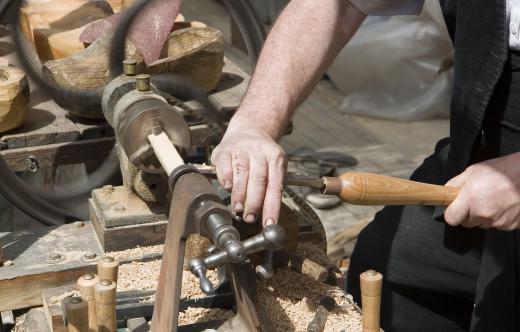A bench lathe is a material reduction machine built into a bench or worktable. A lathe takes a solid block of a material and reduces it to create a symmetrical item. Using a bench lathe, you can cut, knurl, drill, or sand material down to create a new object. The lathe is designed to hold the block at two points and spin it while allow the user to reduce the material to the new shape.
A commonly used example of a lathe is an apple peeler. The apple is held inside the lathe at two points, the top and the bottom. As the crank is turned, the apple rotates along the vertical axis. The peeler is applied to the apple skin and produces an apple peel strip while moving from the stem to the base, reducing the material to reveal a different item. A bench lathe uses the exact same principle, but for larger materials.

A lathe can be used for wood, metal, glass work and pottery. Depending on the skill of the operator, the lathe can produce a simple table leg or a very ornate object. Precision lathes utilize computer software to create very complex designs or to mass produce a specific product.
This type of lathe has a bed or horizontal beam that allows the excess material to fall away from the work surface. The headstock is located on the left hand side of the lathe. A headstock is the section of the lathe that holds the spinning bearings.

Attached to the bench lathe is a spindle. This hollow bar runs parallel to the bed and is used to attach accessories. These accessories secure the workpiece in place. It is very common for these lathes to also have a hand wheel or exterior threads to allow other accessories to be attached to the lathe as required.
On a bench lathe, the spindle moves the block of material with either an electric motor or foot power. It is very common for the motor to be concealed in the headstock or in the base of the lathe bench. If the lathe has a motor in the headstock, it is important to give carefully consideration to where you install the device, and its proximity to a power outlet. It is critical to ensure the electricity cable is secured safely.
When selecting a bench lathe, review the product specifications, type of materials it is designed to work with and the warranty. Look at the price of replacement parts, tools and accessories as part of the total purchasing price of the unit. These parts will need to be replaced in time and quality parts are worth the higher costs. They tend to have a longer productive life and produce better quality results.
